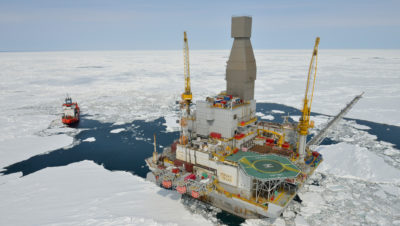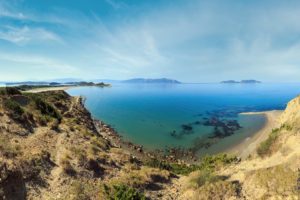Lawyer Richard Ayres has been fighting for the environment in federal courts for nearly five decades, but he says he’s never seen an onslaught on basic environmental protections like the one coming out of the Trump White House. Still, something scares Ayres even more than the determination of the Trump team to dismantle President Barack Obama’s climate change initiatives, shrink federally protected lands, weaken smog standards, scale back habitat for rare species, and expand drilling into the Atlantic and Arctic oceans.
What most unnerves Ayres and other veteran environmental lawyers and legal experts is the unprecedented opportunity President Trump has to fill the federal judiciary with anti-regulatory, pro-business appointees.
Trump has far more openings to fill than previous presidents, and Democrats have far less power to block his nominees than the opposition party has had in the past. And while Trump has trailed his predecessor in nominating officials for the executive branch, he has far outpaced recent presidents in selecting federal judges. So far, he’s nominated 31 judges to fill 140 open slots out of the 890 federal judgeships. By contrast, Obama had 54 openings for federal judges when he took office.
Not only will these judges potentially play a role in upholding Trump’s rollbacks of environmental protections, they likely will remain in their posts for decades after Trump leaves office. Federal judges are appointed for life, and so far Trump’s appointees are younger on average than appointees of previous presidents.
“Trump is going to appoint a lot of judges that will change the complexion of the court system for a long time,” says one expert.
“Trump is going to appoint a lot of judges that will change the complexion of the court system for a long time,” says Ayres, who has been a prominent environmental lawyer since 1970 and was one of the founders of the Natural Resources Defense Council. “It very well could be the biggest impact he has on the environment. Imagine another 10 percent of the judiciary filled with Trump appointees. Environmental organizations will fight back and litigate and save some things, but there’s a whole lot of damage that will take forever to repair — if it’s repairable.”
Among Trump’s early nominees is Ralph Erickson for the 8th U.S. Circuit Court of Appeals in St. Louis. As a judge on the U.S. District Court in North Dakota, Erickson in 2015 blocked the implementation of President Obama’s Clean Water Rule in 13 states that had sued the Environmental Protection Agency; the rule expanded federal jurisdiction over certain streams, wetlands, and headwaters. The Trump administration plans to repeal the rule, a move opposed by conservationists but backed by many agriculture, construction, and energy groups.
The future status of Bears Ears National Monument in Utah may end up being determined in federal court. Bob Wick/BLM
Allison Eid, Trump’s nominee for the 10th Circuit Court of Appeals in Denver, wrote a decision in 2012 for the Colorado Supreme Court that overturned a lower court’s ruling and rejected a community group’s request for a hearing about oil and gas drilling permits near a site where a nuclear bomb was exploded deep underground in 1969. Eid also dissented when the Colorado Supreme Court allowed eminent domain of a corporation’s land to be used for public parks and recreation, yet in a dissent in a separate case she ruled that a pipeline company should be able to use eminent domain for a petroleum pipeline.
These and other Trump judicial nominees will play a role in important environmental cases expected to come before the federal courts in coming years:
- Does a president have the authority to shrink a national monument designated by a predecessor? Presidents can protect historic or natural treasures as national monuments. Trump has ordered reviews of 21 monument areas designated since 1996, saying some monuments are too large and are opposed by local people and businesses. Last week, Interior Secretary Ryan Zinke sent a report to Trump recommending that a handful of national monuments be “altered.” One of those that reportedly may be reduced in size is the Bears Ears National Monument, a 2,100-square mile swath of southern Utah that is the ancestral home of Native Americans and includes many artifacts and archeological remnants, as well as spectacular red rock scenery.
- Do Clean Water Act protections extend to wetlands and seasonal streams? Supreme Court cases in recent decades limited what wetlands and streams are covered by the Clean Water Act. Obama’s Clean Water Rule attempted to end confusion by specifying that streams and wetlands connected to navigable waters are protected even if they’re only wet after storms or seasonally. Trump is moving to repeal this rule. The rollback, which surely will be challenged in federal court, could be enormously consequential in the arid West where many streams flow only after storms or during spring when snow is melting.
- Does the Environmental Protection Agency have the authority to regulate greenhouse gas emissions from power plants? Under the Clean Power Plan, Obama sought to reduce greenhouse gas emissions from power plants. The Trump administration is expected to rescind the plan, a move that would be challenged by environmentalists and some states. The U.S. Supreme Court ruled in 2007 and again in 2014 that the EPA has the authority to regulate greenhouse gas emissions under the Clean Air Act.
- Can a president reverse a predecessor’s decision to withdraw parts of the Atlantic or Arctic oceans from drilling? President Obama banned drilling in the Atlantic Ocean from Virginia to the Canadian border and in most federal waters in the Arctic Ocean. Trump signed an executive order to lift the bans — which environmental groups and native Americans are challenging in court — and is moving to expand drilling in both oceans.
- Can California set its own tougher fuel economy standards to reduce greenhouse gas emissions from vehicles — and may other states join in? The Trump administration is moving to weaken a key part of Obama’s climate change initiatives — a rule that requires boosting average fuel economy for cars and light trucks to nearly 55 miles per gallon. California has a waiver that allows it to pursue tougher fuel economy standards than the federal government’s. The Trump administration may challenge this waiver, which has forced Detroit to make more fuel-efficient cars so they can be sold in the large California market.
- Are Trump’s rollbacks of protections for threatened and endangered species legal? The Trump administration has backed efforts by Republican congressmen to weaken the Endangered Species Act, and the Interior Department has recommended scaling back the Obama administration’s 2015 rule to protect sage grouse across 11 Western States. Zinke’s actions will inevitably be challenged in federal court.
Decisions by conservative judges “will present an existential threat to the clean water, clean air, and habitat of the West,” says one lawyer.
Todd Tucci, senior attorney for the conservation group Advocates for the West, has fought in court for years to protect sagebrush habitat across Idaho, Nevada, and Utah for sage grouse and many other species. Tucci envisions that Trump-appointed judges will make decisions for decades to come that will favor timber, oil, and mining industries to the detriment of sage grouse, wolves, and many other species. “They will present an existential threat to the clean water, clean air, and habitat of the West,” says Tucci.
Other environmental lawyers are more sanguine. They emphasize that it will take Trump time to fill all the empty judicial slots, especially because judges need Senate confirmation. So far, only five Trump judicial appointees have been confirmed. And liberal appointees currently dominate a couple of key federal appeals courts.
“We’re going to win way more than we’re going to lose,” says Drew Caputo, vice president for lands, wildlife, and oceans at Earthjustice, the leading nonprofit environmental law firm. “I think courts will continue to be the place where people who care about the environment can go to hold this administration accountable.”
Conservative legal experts are enthusiastic about the opportunities Trump has to create a federal judiciary more likely to rein in regulation and side with industry and landowners. But some worry that Trump and the Senate won’t be able to take full advantage of the opportunity because of all the drama and disarray in this White House.
Exxon Mobil’s Orlan platform in the Arctic Ocean. The future of oil drilling in U.S. Arctic waters is expected to come before federal courts. Exxon Mobil
“Any other Republican could really make great headway in fashioning the judiciary,” says Jim Burling, who directs litigation for the Pacific Legal Foundation, which represents business and landowners involving the Endangered Species and Clean Water acts. “It depends on how much he gets distracted. Nobody has ever seen anything like the show that’s going on right now.”
Still, the Republican-controlled Senate and Senate Majority Leader Mitch McConnell are expected to be strong allies in transforming the judiciary. Trump has McConnell and Senate Republicans to thank for all the judicial openings he has to fill, as the GOP blocked dozens of Obama’s judicial nominees. Most famously, McConnell refused to schedule floor time for the Senate to vote on Obama’s Supreme Court nominee, Merrick Garland, to replace the late Justice Antonin Scalia.
“Over the previous six years, Republicans in the Senate did everything they could to slow down confirmations,” says Kristine Lucius, executive vice president of the Leadership Conference on Civil and Human Rights, which tracks judicial openings.
With the death of the filibuster, Democrats have few tricks up their sleeves to block Trump’s nominees.
Filibusters requiring 60 of the Senate’s 100 members to confirm a judicial nominee were eliminated during the Obama administration, so Democrats have few tricks up their sleeves to block Trump’s nominees. One Senate tradition could help them. Senators typically are given a chance to review judges who would serve in their states, and can block a nominee by failing to return what’s known as a blue slip. But whether the blue slip will last remains an open question. Big GOP donors like the Koch brothers are pressuring Republicans to stop the tradition of blue slips in order to speed the transition to a more conservative, business-friendly judiciary, according to USA Today.
Without the filibuster, Trump has little incentive to nominate moderate judges. “Trump has almost complete unbridled discretion to jam through whomever [he] wants,” says Tucci.
One thing in environmentalists’ favor is that many environmental cases, especially those involving the Clean Air Act, end up before the U.S. Court of Appeals for the D.C. Circuit. Appointees by Democratic presidents on that court outweigh appointees by Republican presidents 7 to 4. “The balance of power in D.C. Circuit is not going to change under Trump, at least not during the first Trump administration,” predicts Patrick Parenteau, an environmental law professor at Vermont Law School.
The tilt of the D.C. Circuit doesn’t guarantee victory for environmentalists, but judges appointed by Democratic presidents tend to favor outcomes environmentalists want. “Wherever you see a contest with big economic stakes for industry and there’s a choice of interpretation of a statute or a regulation, you can pretty much predict that the Republican-appointed judges are going to be more concerned about the immediate economic cost than the long-term environmental harm of not regulating,” adds Parenteau.
For conservationists, the sooner environmental cases come up for review, the better.
Trump has numerous slots to fill in other appeals courts. For instance, he has already nominated judges for three openings in the 8th Circuit and there are four openings in the 9th Circuit, headquartered in San Francisco.
For conservationists, the sooner environmental cases come up for review, the better. “The courts, with the balances we now have, will probably be helpful (to environmentalists) for a while, but as Trump appoints more and more judges, the courts will be come less and less helpful,” Ayres says.
Even if states, Native American tribes, and environmental groups succeed in federal district court and at the appellate level, the outlook could be bleaker by the time a case reaches the Supreme Court. “This Supreme Court does not have a good record [on environmental cases],” adds Ayres. “And there may be more Trump justices on it by then.”
How successful Trump will be in transforming the federal judiciary depends on how long he keeps his job. “If Trump gets only one term, he will certainly have an impact,” says Mark Squillace, the director of the Natural Resources Law Center at the University of Colorado. “If he has two terms, I think the courts would fundamentally change.”




